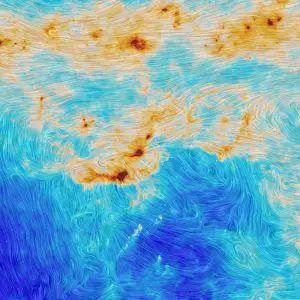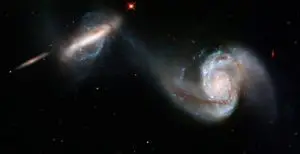
Do single stars tend to rotate in the same direction as the Sun and/or the Galaxy?
This is a more technical question, so I am going to give a more technical answer, but first the simple answer.
No, the rotation of a single star is not aligned with the galactic rotation because there are more dominant forces on stars while they are forming. The most dominant force for forming stars is turbulence.
Now the more technical answer. To cause rotation, the angular momentum of the galaxy (i.e., the amount and direction of its spin) would need to be imparted to the stars. This does happen when planets form and when galaxies merge, but not when stars form.
Here are some examples of each of these cases.
 The steps for planet formation are:
The steps for planet formation are:
- A large cloud of gas and dust inside a molecular cloud collapses to form a star.
- The material around the star interacts through physical collisions and the young stars magnetic field.
- The disk of material stays in orbit around the star for millions of years and is able to form planets as the material interacts.
In many planetary systems this coevolution of the star, disk and planet causes them to rotate and orbit in the same direction. However, this simple story is easily complicated by giant planet interactions and multiple star systems.
 The steps for galaxy formation are:
The steps for galaxy formation are:
- Dark matter halos collect the gas and dust from the intergalactic medium.
- Little galaxies form in little dark matter halos that are gravitationally interacting in a galaxy cluster.
- The little galaxies interact and merge. This is very chaotic and causes some very interesting morphologies.
Even though planets go around their host star millions of times while they form, galaxies have only interacted a few times and so they are still randomly oriented relative to each other.
The steps for normal star formation are:
- Density waves inside the disk of the Galaxy create spiral arms and molecular clouds.
- These clouds are turbulent, and it is not well known if this turbulence helps or hinders star formation.
- The molecular cloud fragments to form a cluster of stars. Each star is its own little collapsing cloud of gas and dust.
The scale of star formation is uniquely different from galaxies and planets, and stars essentially form in isolation.
In numbers: the distance between the Milky Way and Andromeda is 780 kiloparsecs, and the Milky Way is 30 kiloparsecs across – so the separation is 26 times the size of the Galaxy. The average distance between the material in a planet forming disk is not much more than zero since there is physical interaction. However, stars in a molecular cloud are separated by 1-10 parsecs on average, which is about 10 million times the size of the young star.
Once the gas and dust starts to collapse into a star, the material concentrates in the center and the outer material uncouples from the cloud. This isolation of a star, that is embedded in the molecular cloud, makes it difficult for the galactic rotation to get imprinted on the forming star. The turbulence of the material in the molecular cloud is a more dominant force in deciding the angular momentum of the young star. As the cloud collapses, a small amount of rotation from turbulence is amplified and the star spins faster thanks to the conservation of angular momentum. Turbulence is dominant enough that all the stars that form in a star cluster have random rotation axes.
Dr. Gregory Mace
UT Austin